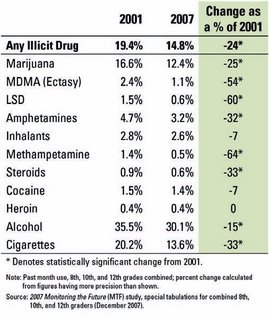 president bush released the 2008 national drug control strategy this weekend. the table at left uses data from the venerable monitoring the future study to establish a six-year decline in prevalence rates for the most common licit and illicit drugs.
president bush released the 2008 national drug control strategy this weekend. the table at left uses data from the venerable monitoring the future study to establish a six-year decline in prevalence rates for the most common licit and illicit drugs.
i was a bit skeptical of this chart at first, since it only shows two years, the mtf only samples in-school youth, and it seems hinky to pool respondents in 8th, 10th, and 12th grade. nevertheless, the downward trend is real — especially since the peaks of the mid-1990s.
the most recent mtf press release indicates steep declines in marijuana, speed, and meth, alcohol, and cigarettes. drugs “holding steady” from 2006-2007 include powder and crack cocaine, lsd, heroin, ecstasy, steroids, and most of the prescription-type drugs such as oxycontin and vicodin. still, prevalence rates for these drugs were well off their earlier peaks as well.
one finding from the introduction to the national drug control strategy might be of interest to demographers: figure 4. baby boomers are carrying higher rates of drug use with them as they age. i can’t link directly to the figure, but here’s the accompanying text:
One of the more disturbing data trends identified in the past several years is a dramatic rise in current drug use among adults aged 50-54 (see Figure 4). This trend does not necessarily mean that people are taking up drug use as they enter middle age, but rather that a segment of the population that experienced high rates of drug use in their youth continue to carry high rates of use with them as they get older. While drug use is a burden that the baby boomer generation has borne into middle age, the generation coming of age today will benefit from comparatively lower rates of drug use for the rest of their lives.
this seems like a classic age/cohort/period illustration that might be useful in the classroom. when i report substance use data from the late-1970s and early-1980s, i now tell students that many drugs were more prevalent in their parents’ high schools in 1982 than in their own high schools in 2007. i sometimes have difficulty convincing the students of this, which is sort of sweet. when they do believe me, however, i advise them to repeat my lecture around the dinner table at a big family gathering — you know, like when grandma and grandpa are in the room. that way, both the kids and the elders can have a little fun with the baked-est generation.

Comments 2
Emma — January 25, 2020
in-school youth, and it seems hinky to pool respondents in 8th, 10th, and 12th grade. nevertheless, the downward trend is real — especially since the peaks of the mid-1990s.
MarySW — May 27, 2020
Interesting article. But scary statistics. When I do not want to think about what is happening, I play online slots. It helps me relax. Most of all I like the sizzling hot slot online. I think you will appreciate it too.